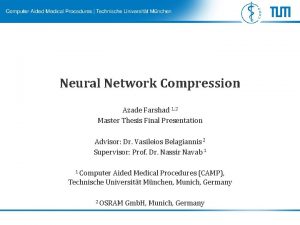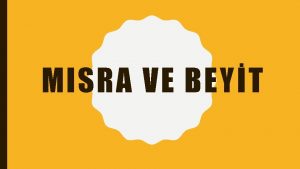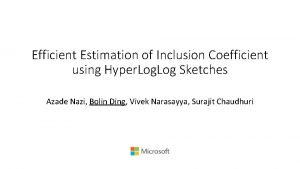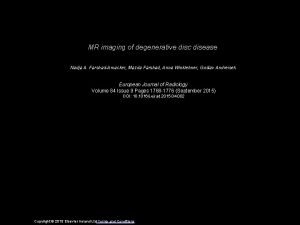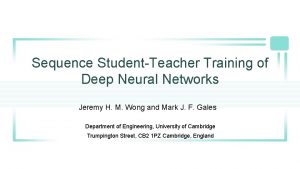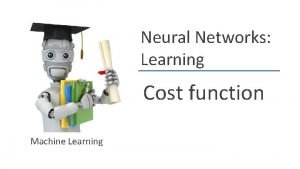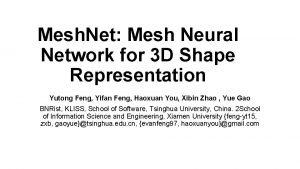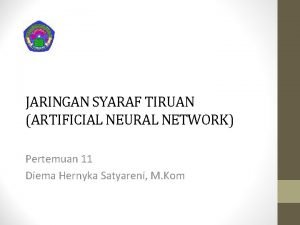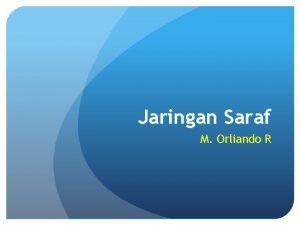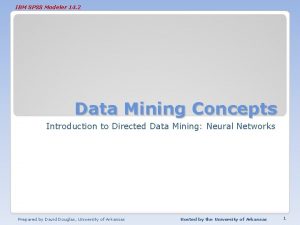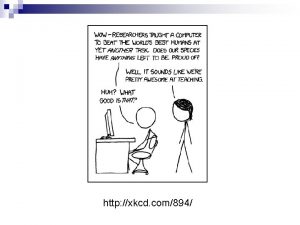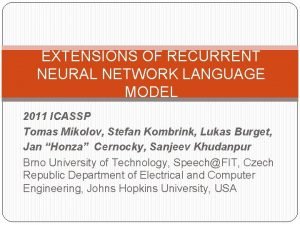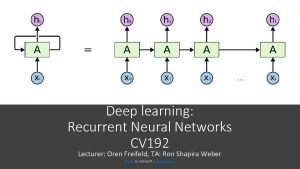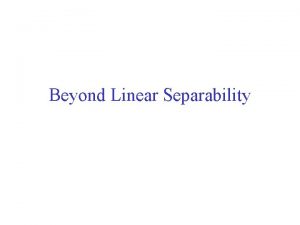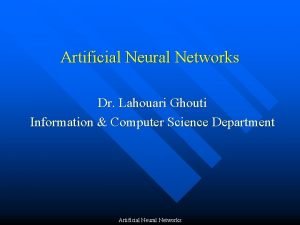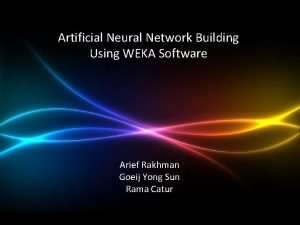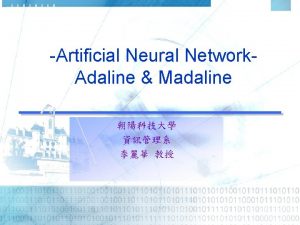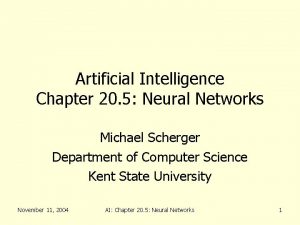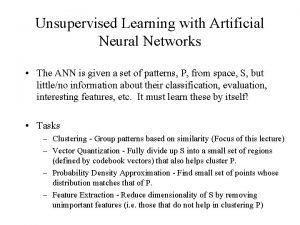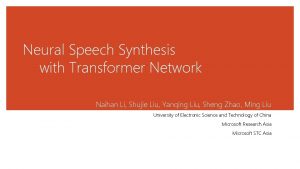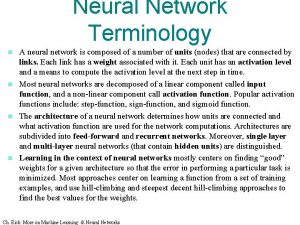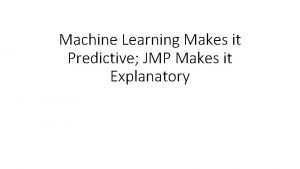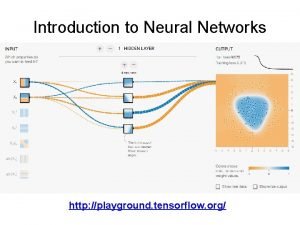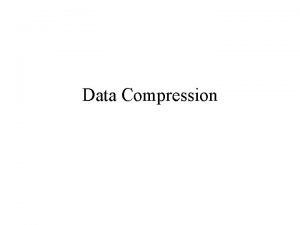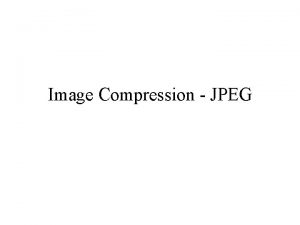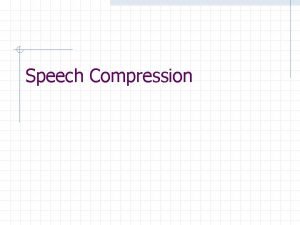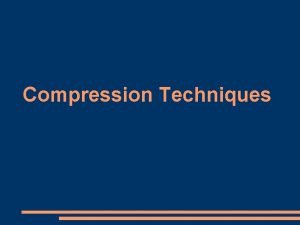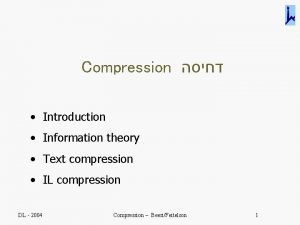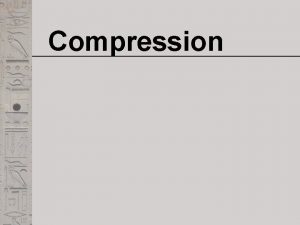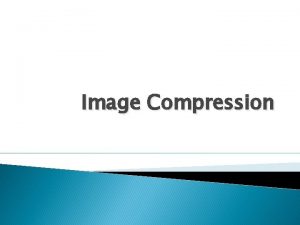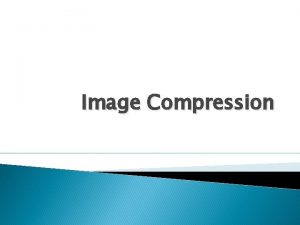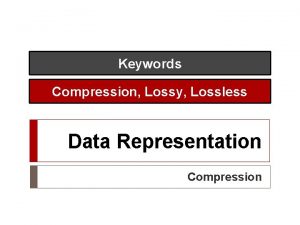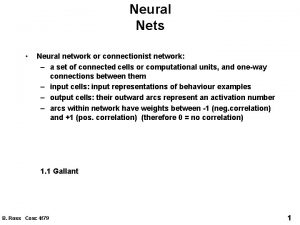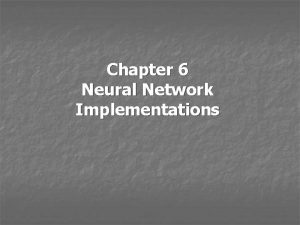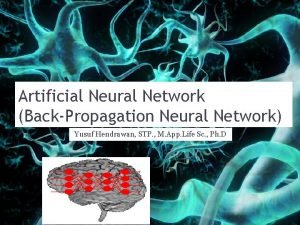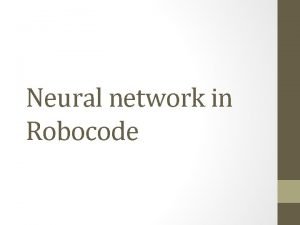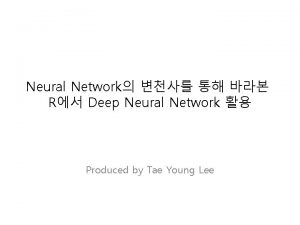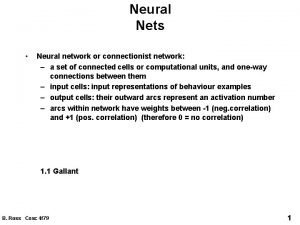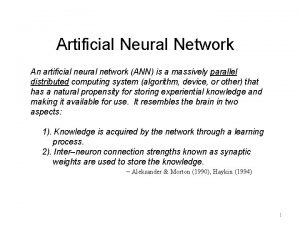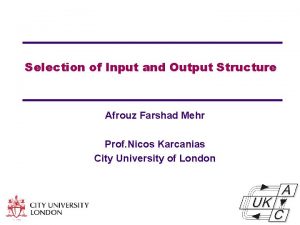Neural Network Compression Azade Farshad 1 2 Master





![Network Compression - Pruning and Parameter sharing • Pruning filters [9] – Whole filters Network Compression - Pruning and Parameter sharing • Pruning filters [9] – Whole filters](https://slidetodoc.com/presentation_image_h/745d1756c7cdef2ee60d4d36c46cbbba/image-6.jpg)
![Network Compression - Factorization • Low Rank Expansion [11] – – Basis filter set Network Compression - Factorization • Low Rank Expansion [11] – – Basis filter set](https://slidetodoc.com/presentation_image_h/745d1756c7cdef2ee60d4d36c46cbbba/image-7.jpg)
![Network Compression - Factorization • Mobile. Nets [12] – – Depthwise Separable Convolution Pointwise Network Compression - Factorization • Mobile. Nets [12] – – Depthwise Separable Convolution Pointwise](https://slidetodoc.com/presentation_image_h/745d1756c7cdef2ee60d4d36c46cbbba/image-8.jpg)
![Network Compression - Factorization • Mobile. Nets [12] – – • Depthwise Separable Convolution Network Compression - Factorization • Mobile. Nets [12] – – • Depthwise Separable Convolution](https://slidetodoc.com/presentation_image_h/745d1756c7cdef2ee60d4d36c46cbbba/image-9.jpg)
![Network Compression - Distillation • L 2 – Ba [14] Student Network Teacher Network Network Compression - Distillation • L 2 – Ba [14] Student Network Teacher Network](https://slidetodoc.com/presentation_image_h/745d1756c7cdef2ee60d4d36c46cbbba/image-10.jpg)
![Network Compression - Distillation • L 2 – Ba [14] Teacher Network Student Network Network Compression - Distillation • L 2 – Ba [14] Teacher Network Student Network](https://slidetodoc.com/presentation_image_h/745d1756c7cdef2ee60d4d36c46cbbba/image-11.jpg)
![Network Compression - Distillation • L 2 – Ba [14] Teacher Network Student Network Network Compression - Distillation • L 2 – Ba [14] Teacher Network Student Network](https://slidetodoc.com/presentation_image_h/745d1756c7cdef2ee60d4d36c46cbbba/image-12.jpg)
















- Slides: 28

Neural Network Compression Azade Farshad 1, 2 Master Thesis Final Presentation Advisor: Dr. Vasileios Belagiannis 2 Supervisor: Prof. Dr. Nassir Navab 1 1 Computer Aided Medical Procedures (CAMP), Technische Universität München, Munich, Germany 2 OSRAM Gmb. H, Munich, Germany

Introduction • Why compression? – Hardware constraints – Faster execution – Goal: better performance, less memory and storage, deployment on devices with limited resources • Research directions – – • Quantization and Binarization Parameter pruning and sharing Factorization Distillation (Dark knowledge) Evaluation metrics – Speed: FLOPs (Floating point operations) – Memory: number of parameters – Accuracy: classification Neural Network Compression – Azade Farshad 2

Network Compression - Quantization • 32 bit → 16 bit, 8 bit, … – Speed increase – Memory usage decrease • • Minimal loss of accuracy Linear 8 -bit quantization [1] – Weights and biases normalized to fall in range [-128, 127] – ~3. 5 x memory reduction • Incremental Network Quantization [2] – Weights: zero or different powers of two – Three steps • Weight partition • Group-wise quantization • Retraining [1] Vanhoucke, Vincent, Andrew Senior, and Mark Z. Mao. "Improving the speed of neural networks on CPUs. " NIPS Workshop, vol. 1, p. 4. 2011. [2] A. Zhou, A. Yao, Y. Guo, L. Xu, and Y. Chen. Incremental network quantization: Towards lossless cnns with low precision weights. ar. Xiv, 2017. Neural Network Compression – Azade Farshad 3

Network Compression - Binarization • • • 1 -bit precision Speed increase due to less complex calculations and less space in memory Binaryconnect [3] – Binarized in FP and BP, Same precision in weight update • XNOR-Net [4] Figure 1 (available at [5]) – Binarized weights and operations – High loss of accuracy – Over 30 x latency and memory usage reduction Figure 1. Binary networks [5] [3] M. Courbariaux, Y. Bengio, and J. -P. David, “Binaryconnect: Training deep neural networks with binary weights during propagations, ” NIPS, 2015. [4] M. Rastegari, V. Ordonez, J. Redmon, and A. Farhadi, “Xnor-net: Imagenet classification using binary convolutional neural networks, ” ECCV, 2016. [5] https: //ai. intel. com/accelerating-neural-networks-binary-arithmetic/ Neural Network Compression – Azade Farshad 4

Network Compression - Pruning • Removal of redundant connections or neurons from the network – Connections with low weight – Neurons or filters with low impact • Learning weights and connections [6] Figure 1 (available at [8]) – Train connections => Prune => Retrain • Deep Compression [7] – Pruning + Quantization + Huffman coding – Minimal loss of accuracy, up to 35 x compression in model size Figure 2. Pruning neurons or connections [8] [6] S. Han, J. Pool, J. Tran, and. W. Dally. Learning both weights and connections for efficient neural network. NIPS, 2015. [7] S. Han, H. Mao, and W. J. Dally. Deep compression: Compressing deep neural networks with pruning, trained quantization and huffman coding. ar. Xiv, 2015. [8] https: //www. oreilly. com/ideas/compressed-representations-in-the-age-of-big-data Neural Network Compression – Azade Farshad 5
![Network Compression Pruning and Parameter sharing Pruning filters 9 Whole filters Network Compression - Pruning and Parameter sharing • Pruning filters [9] – Whole filters](https://slidetodoc.com/presentation_image_h/745d1756c7cdef2ee60d4d36c46cbbba/image-6.jpg)
Network Compression - Pruning and Parameter sharing • Pruning filters [9] – Whole filters with connecting feature maps are pruned – 4. 5 x speed up with minimal loss of accuracy • Hashed. Nets [10] – – Parameter sharing approach Low-cost hash functions Weights grouped in hash buckets Accuracy increase with 8 x memory usage reduction [9] H. Li, A. Kadav, I. Durdanovic, H. Samet, and H. P. Graf. Pruning filters for efficient convnets. ar. Xiv, 2016. [10] W. Chen, J. Wilson, S. Tyree, K. Weinberger, and Y. Chen. Compressing neural networks with the hashing trick. ICML, 2015. Neural Network Compression – Azade Farshad 6
![Network Compression Factorization Low Rank Expansion 11 Basis filter set Network Compression - Factorization • Low Rank Expansion [11] – – Basis filter set](https://slidetodoc.com/presentation_image_h/745d1756c7cdef2ee60d4d36c46cbbba/image-7.jpg)
Network Compression - Factorization • Low Rank Expansion [11] – – Basis filter set => Basis feature maps Final feature map = linear combination of basis feature maps Rank-1 basis filter => decomposed into a sequence of horizontal and vertical filters ~2. 4 x speedup, no performance drop Figure 1 (available at [11]) Figure 3. Filter decomposition [11] M. Jaderberg, A. Vedaldi, and A. Zisserman, “Speeding up Convolutional Neural Networks with Low Rank Expansions, ” BMVC, 2014. [12] A. G. Howard et al. , “Mobilenets: Efficient convolutional neural networks for mobile vision applications, ” 2017. [13] X. Zhang, X. Zhou, M. Lin, and J. Sun, “Shufflenet: An extremely efficient convolutional neural network for mobile devices, ” ar. Xiv, 2017. Neural Network Compression – Azade Farshad 7
![Network Compression Factorization Mobile Nets 12 Depthwise Separable Convolution Pointwise Network Compression - Factorization • Mobile. Nets [12] – – Depthwise Separable Convolution Pointwise](https://slidetodoc.com/presentation_image_h/745d1756c7cdef2ee60d4d36c46cbbba/image-8.jpg)
Network Compression - Factorization • Mobile. Nets [12] – – Depthwise Separable Convolution Pointwise + Depthwise convolution 70. 2% accuracy on Image. Net ~7 x less parameters and FLOPs (b) Depthwise Convolutional Filters (a) Standard Convolution Filters (c) 1 x 1 Convolutional Filters called Pointwise Convolution in the context of Depthwise Separable Convolution Figure 4. Depthwise convolution vs. Standard convolution [12] [11] M. Jaderberg, A. Vedaldi, and A. Zisserman, “Speeding up Convolutional Neural Networks with Low Rank Expansions, ” BMVC, 2014. [12] A. G. Howard et al. , “Mobilenets: Efficient convolutional neural networks for mobile vision applications, 2017. [13] X. Zhang, X. Zhou, M. Lin, and J. Sun, “Shufflenet: An extremely efficient convolutional neural network for mobile devices, ” ar. Xiv, 2017. Neural Network Compression – Azade Farshad 8
![Network Compression Factorization Mobile Nets 12 Depthwise Separable Convolution Network Compression - Factorization • Mobile. Nets [12] – – • Depthwise Separable Convolution](https://slidetodoc.com/presentation_image_h/745d1756c7cdef2ee60d4d36c46cbbba/image-9.jpg)
Network Compression - Factorization • Mobile. Nets [12] – – • Depthwise Separable Convolution Pointwise + Depthwise convolution 70. 2% accuracy on Image. Net ~7 x less parameters and FLOPs Shuffle. Net [13] – – Figure 2 (available at [13]) Pointwise group convolutions Channel shuffle Outperforms Mobile. Nets by 7. 2% 13 x speed up while maintaining the accuracy of Alex. Net Figure 5. Shuffle. Net unit [13] [11] M. Jaderberg, A. Vedaldi, and A. Zisserman, “Speeding up Convolutional Neural Networks with Low Rank Expansions, ” BMVC, 2014. [12] A. G. Howard et al. , “Mobilenets: Efficient convolutional neural networks for mobile vision applications, 2017. [13] X. Zhang, X. Zhou, M. Lin, and J. Sun, “Shufflenet: An extremely efficient convolutional neural network for mobile devices, ” ar. Xiv, 2017. Neural Network Compression – Azade Farshad 9
![Network Compression Distillation L 2 Ba 14 Student Network Teacher Network Network Compression - Distillation • L 2 – Ba [14] Student Network Teacher Network](https://slidetodoc.com/presentation_image_h/745d1756c7cdef2ee60d4d36c46cbbba/image-10.jpg)
Network Compression - Distillation • L 2 – Ba [14] Student Network Teacher Network – L 2 loss between teacher and student logits – No labels required L 2 Loss Figure 6. Teacher-Student model, L 2 [14] J. Ba and R. Caruana, “Do deep nets really need to be deep? ” In Advances in neural information processing systems, 2014, pp. 2654– 2662. [15] G. Hinton, O. Vinyals, and J. Dean, “Distilling the knowledge in a neural network, ” Ar. Xiv preprint ar. Xiv: 1503. 02531, 2015. [16] A. Romero, N. Ballas, S. E. Kahou, A. Chassang, C. Gatta, and Y. Bengio, “Fitnets: Hints for thin deep nets, ” Ar. Xiv preprint ar. Xiv: 1412. 6550, 2015. Neural Network Compression – Azade Farshad 10
![Network Compression Distillation L 2 Ba 14 Teacher Network Student Network Network Compression - Distillation • L 2 – Ba [14] Teacher Network Student Network](https://slidetodoc.com/presentation_image_h/745d1756c7cdef2ee60d4d36c46cbbba/image-11.jpg)
Network Compression - Distillation • L 2 – Ba [14] Teacher Network Student Network – L 2 loss between teacher and student logits – No labels required • Knowledge Distillation [15] – Soft target: softmax cross entropy with teacher logits – Hard target: softmax cross entropy with correct labels softmax Figure 7. Teacher-Student model, KD [14] J. Ba and R. Caruana, “Do deep nets really need to be deep? ” In Advances in neural information processing systems, 2014, pp. 2654– 2662. [15] G. Hinton, O. Vinyals, and J. Dean, “Distilling the knowledge in a neural network, ” Ar. Xiv preprint ar. Xiv: 1503. 02531, 2015. [16] A. Romero, N. Ballas, S. E. Kahou, A. Chassang, C. Gatta, and Y. Bengio, “Fitnets: Hints for thin deep nets, ” Ar. Xiv preprint ar. Xiv: 1412. 6550, 2015. Neural Network Compression – Azade Farshad 11
![Network Compression Distillation L 2 Ba 14 Teacher Network Student Network Network Compression - Distillation • L 2 – Ba [14] Teacher Network Student Network](https://slidetodoc.com/presentation_image_h/745d1756c7cdef2ee60d4d36c46cbbba/image-12.jpg)
Network Compression - Distillation • L 2 – Ba [14] Teacher Network Student Network – L 2 loss between teacher and student logits – No labels required • Knowledge Distillation [15] – Soft target: softmax cross entropy with teacher logits – Hard target: softmax cross entropy with correct labels • Fit. Nets [16] – Knowledge Distillation with hints in the middle points of the network – Student is deeper than the teacher labels softmax Figure 8. Teacher-Student model, Fit. Nets [14] J. Ba and R. Caruana, “Do deep nets really need to be deep? ” In Advances in neural information processing systems, 2014, pp. 2654– 2662. [15] G. Hinton, O. Vinyals, and J. Dean, “Distilling the knowledge in a neural network, ” Ar. Xiv preprint ar. Xiv: 1503. 02531, 2015. [16] A. Romero, N. Ballas, S. E. Kahou, A. Chassang, C. Gatta, and Y. Bengio, “Fitnets: Hints for thin deep nets, ” Ar. Xiv preprint ar. Xiv: 1412. 6550, 2015. Neural Network Compression – Azade Farshad 12

Network Compression - Comparison Method Advantages Disadvantages Binarization & Quantization Low latency and memory usage High loss of accuracy Pruning Prevents overfitting, the accuracy can increase Converges slower needs manual setup of layer sensitivity Factorization Can achieve state of the art results while decreasing the computation cost Dependent on framework Distillation Applicable to all architectures Doesn’t change the network KD needs labels => only applicable to classification task Neural Network Compression – Azade Farshad 13

Distillation baseline objectives • L 2 - Ba et al. : • Knowledge Distillation - Hinton et al. : • Fit. Nets - Romero et al. : Neural Network Compression – Azade Farshad 14

Adversarial Network Compression • • • Network Compression using Adversarial training + Distillation Motivation: Generative Adversarial Networks [17] Goal: improving performance of distillation Teacher Network Student Network Adversarial Training Figure 9. Adversarial Network Compression [17] I. Goodfellow, J. Pouget-Abadie, M. Mirza, B. Xu, D. Warde-Farley, S. Ozair, A. Courville, and Y. Bengio. Generative adversarial nets. In Advances in neural information processing systems, pages 2672– 2680, 2014. Neural Network Compression – Azade Farshad 15

Generative Adversarial Networks • • Goal: generating real images Two networks competing – Generator: fake images • Input: random noise • Output: images – Discriminator • Input: image samples • Output: real or fake? • Learning Objective • Conditional GAN [18] – The input can be conditioned on labels or other images Figure 10. Generative Adversarial Network [17] I. Goodfellow, J. Pouget-Abadie, M. Mirza, B. Xu, D. Warde-Farley, S. Ozair, A. Courville, and Y. Bengio. Generative adversarial nets. In Advances in neural information processing systems, pages 2672– 2680, 2014. [18] M. Mirza and S. Osindero, “Conditional generative adversarial nets, ” Ar. Xiv preprint ar. Xiv: 1411. 1784, 2014. Neural Network Compression – Azade Farshad 16

Adversarial Network Compression • Three components Teacher Network Student Network – Student: Generator, fake – Teacher: real – Discriminator: Student or Teacher? • Learning objectives – Knowledge transfer: L 2 loss between teacher and student Dropout Discriminator – Adversarial loss L 2 Figure 9. Adversarial Network Compression – Full objective Neural Network Compression – Azade Farshad 17

Adversarial Network Compression • Network structure Teacher Network Student Network – Teacher (e. g. Res. Net-164) • Input: image sample • Outputs: logits, features – Student: (e. g. Res. Net-20) • Input: image sample • Outputs: logits, features Dropout – Discriminator: 3 layer FCN • Input: student, teacher, adversary features – Adversary (student) + dropout – Similar to noise input from [19] • Output: Teacher/Student Discriminator L 2 Figure 9. Adversarial Network Compression – L 2 loss • Input: student and teacher logits [19] Arjovsky M, Bottou L. Towards principled methods for training generative adversarial networks. ar. Xiv preprint ar. Xiv: 1701. 04862. 2017 Jan 17. . Neural Network Compression – Azade Farshad 18

Discriminator regularization • • Discriminator gets too strong due to low input dimensionality Regularization Methods: – L 1/L 2 regularization [20] – Proposed regularization: Updating discriminator with adversary samples • Dynamic, dependent on student strength [20] A. Y. Ng, “Feature selection, l 1 vs. l 2 regularization, and rotational invariance, ” in Proceedings of the Twenty-first International Conference on Machine Learning, ser. ICML , 2004. Neural Network Compression – Azade Farshad 19

Experiments • Six datasets: – MNIST, Fashion-MNIST, CIFAR-100, SVHN, Image. Net • Network architectures: – Res. Net [21] – Network in Network [22] – Le. Net-4 [23] • Evaluation metrics: – Classification error – Network parameters [21] K. He, X. Zhang, S. Ren, and J. Sun, “Identity mappings in deep residual networks, ” in European Conference on Computer Vision, Springer, 2016. [22] M. Lin, Q. Chen, and S. Yan, “Network in network, ” Ar. Xiv preprint ar. Xiv: 1312. 4400, 2013. [23] Y. Le. Cun, B. E. Boser, J. S. Denker, D. Henderson, R. E. Howard, W. E. Hubbard, and L. D. Jackel, “Handwritten digit recognition with a back-propagation network, ” in NIPS 1990. Neural Network Compression – Azade Farshad 20

Experiments - Continued • Experiments: – – • Regularization methods Discriminator architectures Discriminator input variations Comparison between different network compression methods Training method: – Pretrained teacher using labels – Random initialization of student and discriminator Neural Network Compression – Azade Farshad 21

Evaluation - Discriminator architecture ● ● Teacher and Student networks, dataset, regularization method and input to discriminator: Fixed Discriminator architecture: Varied Architecture * fc: fully connected layer * conv: convolutional layer Top-1 Error [%] on CIFAR-100 128 fc - 256 fc - 128 fc 32. 45 64 fc - 128 fc - 256 fc 32. 78 256 fc - 256 fc 32. 82 256 fc - 128 fc - 64 fc 33. 05 500 fc - 500 fc 33. 28 256 fc - 64 fc 33. 46 128 conv - 256 conv 33. 68 128 fc - 128 fc 33. 72 64 fc - 64 fc 33. 51 64 fc - 128 fc - 64 fc 33. 09 Neural Network Compression – Azade Farshad 22

Evaluation - Regularization method ● ● ● Networks, discriminator architecture and input to discriminator: Fixed Regularization method: Varied Our proposed regularization: Updating discriminator with adversarial samples Dataset Teacher Student Top-1 Error [%] w/o regularization L 1 L 2 Ours CIFAR-10 Res. Net-164 Res. Net-20 10. 07 8. 19 8. 16 8. 08 CIFAR-100 Res. Net-164 Res. Net-20 34. 10 33. 36 33. 02 32. 45 SVHN Res. Net-164 Res. Net-20 3. 73 3. 67 3. 68 3. 66 Fashion-MNIST Ni. N Le. Net-4 9. 62 8. 91 8. 75 8. 61 MNIST Ni. N Le. Net-4 1. 14 1. 03 0. 96 Neural Network Compression – Azade Farshad 23

Evaluation - Different inputs to discriminator ● ● Fixed network, discriminator architecture Input to discriminator ○ Logits, Logits + dropout, Features + dropout Dataset Teacher Student Top-1 Error [%] Supervised Teacher Supervised Student logits + dropout features + dropout CIFAR-100 Res. Net-164 Res. Net-20 27. 76 33. 36 33. 9 33. 41 33. 40 32. 45 SVHN Res. Net-164 Res. Net-20 3. 98 4. 20 3. 74 3. 81 3. 74 3. 66 Fashion-MNIST Ni. N Le. Net-4 7. 98 8. 77 8. 90 8. 84 8. 86 8. 61 Image. Net Res. Net-152 Res. Net-18 27. 63 43. 33 - - 33. 31 32. 89 Image. Net Res. Net-152 Res. Net-50 27. 63 30. 30 - - - 27. 86 Neural Network Compression – Azade Farshad 24

Evaluation - Comparison between compression methods ● Evaluation on CIFAR-10 and CIFAR-100 Model (CIFAR-10) Error [%] Parameters Model (CIFAR-100) Error [%] Parameters L 2 - Ba et al. [14] 9. 07 0. 27 M L 2 - Ba et al. [14] 32. 79 0. 27 M KD - Hinton et al. [15] 8. 88 0. 27 M KD - Hinton et al. [15] 33. 34 0. 27 M Quantization [24] 8. 87 0. 27 M Fit. Nets [16] 35. 04 2. 5 M Fit. Nets [16] 8. 39 2. 5 M Yim et al. [25] 36. 67 - Binary. Connect [3] 8. 27 15. 20 M Adversarial Compression 32. 45 0. 27 M Yim et al. [25] 11. 30 - Adversarial Compression 8. 08 0. 27 M [24] C. Zhu, S. Han, H. Mao, and W. J. Dally, “Trained ternary quantization, ” Ar. Xiv preprint ar. Xiv: 1612. 01064, 2016. [25] J. Yim, D. Joo, J. Bae, and J. Kim, “A gift from knowledge distillation: Fast optimization, network minimization and transfer learning, ” in 2017 IEEE Conference on Computer Vision and Pattern Recognition (CVPR), Jul. 2017. Neural Network Compression – Azade Farshad 25

Comparison to other well-known networks on Image. Net Neural Network Compression – Azade Farshad 26

Conclusion • • • Adversarial compression achieves better performance than similar approaches without need of labels Discriminator regularization is needed for best performance Dropout on adversary improves performance by preventing trivial solutions Adversarial compression decreases the number of teacher parameters significantly with minimal loss of accuracy There is a trade-off between speed and accuracy Neural Network Compression – Azade Farshad 27

Thank you for your attention! Questions? Neural Network Compression – Azade Farshad 28
 Vasileios belagiannis
Vasileios belagiannis Mısra i azade
Mısra i azade Hypercommercialism definition
Hypercommercialism definition 1776
1776 Lateralization
Lateralization Least mean square algorithm in neural network
Least mean square algorithm in neural network Student teacher neural network
Student teacher neural network Cost function in deep learning
Cost function in deep learning Threshold logic unit in neural network
Threshold logic unit in neural network Meshnet: mesh neural network for 3d shape representation
Meshnet: mesh neural network for 3d shape representation Pengertian artificial neural network
Pengertian artificial neural network Neural network in r
Neural network in r Matlab neural network toolbox
Matlab neural network toolbox Spss neural network
Spss neural network Xkcd neural network
Xkcd neural network Extensions of recurrent neural network language model
Extensions of recurrent neural network language model Lstm colah
Lstm colah Cnn ppt
Cnn ppt Linear separability in neural network
Linear separability in neural network Artificial neural network in data mining
Artificial neural network in data mining Least mean square algorithm in neural network
Least mean square algorithm in neural network Weka neural network
Weka neural network Adaline neural network
Adaline neural network Decision boundary of neural network
Decision boundary of neural network Maxnet neural network
Maxnet neural network Parallel tacotron 2
Parallel tacotron 2 Artificial neural network terminology
Artificial neural network terminology Jmp pca
Jmp pca Playground tensorflow org
Playground tensorflow org
